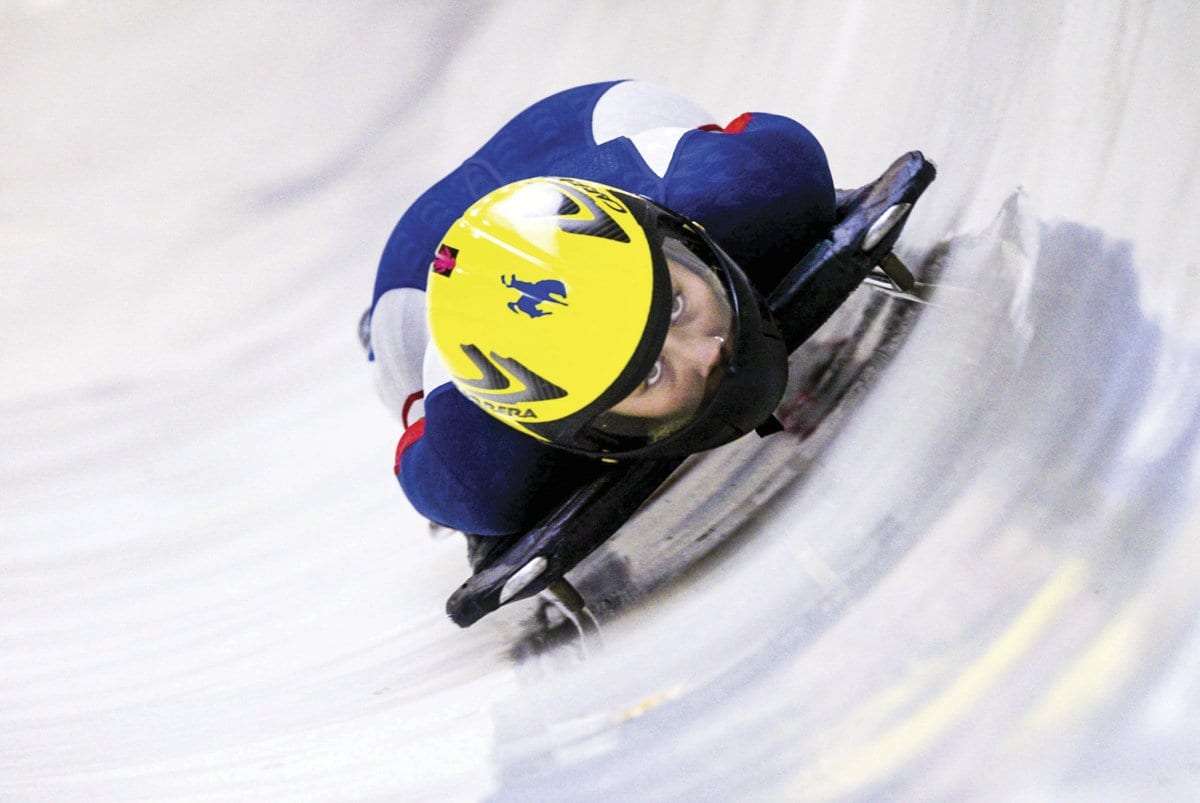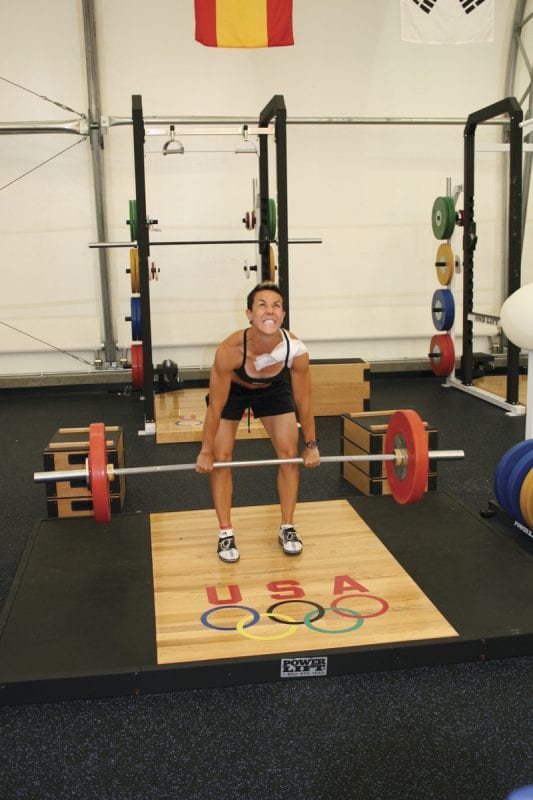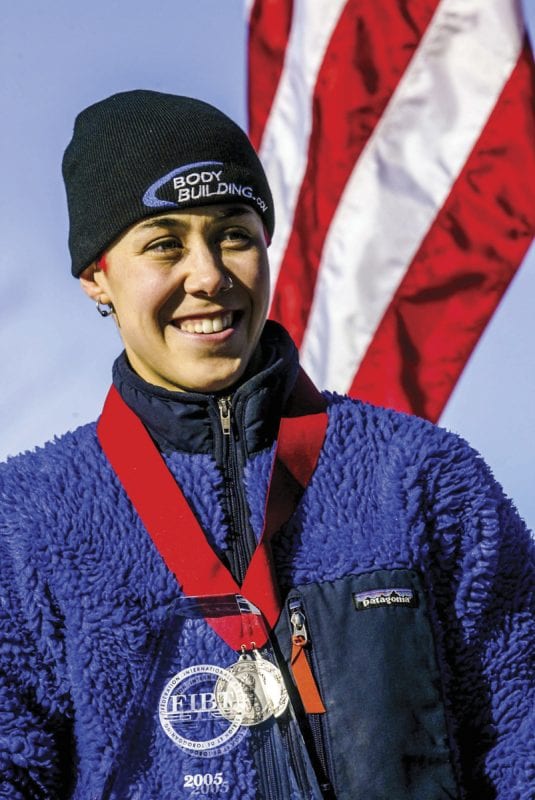
How one moment in 2004 changed two lives, a dream and a training course
By James M. Odato
It snowed hard and the wind blew strong and cold in Lake Placid on the afternoon of Jan. 22, 2004.
Looking down the icy bobsled run atop Mount Van Hoevenberg, world-class skeleton racer Courtney Yamada clutched her 75-pound sled, a piece of metal on knifelike blades. She heard a verbal signal that the track was clear. She trained her eye on the traffic light. When it turned from red to green she had 30 seconds to slide onto the track and speed face-first downhill like a flash.
A half-hour earlier, David Desrocher had arrived for work on the mountain. He was three months into the job as a laborer for the Olympic Regional Development Authority, which runs the bobsled facility at Van Hoevenberg and other alpine and Nordic venues owned by the state. His normal job was to drive sleds from the bottom to the top of the bobrun. But he had come in early because the America’s Cup training was underway and he could get extra hours. His boss assigned him to join the crew that cleared the track of snow in between runs.
He didn’t like that. Today, ORDA says it requires training for on-track workers and employs strict track announcement protocols. On this day, though, Desrocher said, he had never performed his task before and hadn’t received any training.
He walked to mid-track, grabbed a shovel and entered the run with another man. They removed snow so it wouldn’t fly into the faces of speeding sliders. Desrocher pulled his headband over his freezing ears.
Yamada got the green light and did what she had done hundreds of times on the legendary Olympic hill. She took off real fast.
She was approaching 70 mph when she whipped around Curve 14 and entered the straightaway called Shakine. There, she saw two men with shovels on the ice in front of her.
Desrocher, facing downhill, never saw or heard Yamada coming. “She hit both ankles,” he said. “My boot came off on the left and they found it about 30 feet away, and I tie my boots tight.” Desrocher suffered a concussion and foot and shoulder injuries. His crewmate, Philip Dever, was struck a moment later. The sled clipped his ankle. “It was a thunk,” Dever told lawyers later. “Hard. Real hard.”
“I remember driving my feet to try to slow down, and then, impact,” Yamada said. “I plowed through them like bowling pins.” She shattered her clavicle. “I tried to pick my arm up to get it back up on the sled; it wouldn’t pick up.”
Bruised and scraped, she was transported to the hospital. She was 24 and one of the top four women’s skeleton competitors on the U.S. national team, gaining every year in her goal of an Olympic berth.
Instead of continuing on a worldwide series of sliding competitions, Yamada underwent a series of medical procedures and recoveries that season. To put her collarbone back together, she required a bone graft. The surgeon mixed bone fragments with putty, inserted a six-hole locking plate and screwed it into her bone. The pain was excruciating, even during the three weeks she was in a sling. A 3-inch scar marks the spot.
Committed to conditioning, the 5-foot-1-inch Yamada went home to the Olympic Training Center in Lake Placid. She resumed weightlifting, focusing on lower body, and exercised to try to avoid muscle atrophy. She could not do a lot of her usual routine. The medicine ball toss, bench presses and pushups were out.
“Pound for pound, she may have been one of the best athletes per se,” said Orvie Garrett, her coach. She was not one to “sit around” in the gym.
“As a small human, she was fast and strong,” former assistant U.S. skeleton coach Greg Sand said. “She had one of the best starts on the team.”
When they trained in San Diego about two years after her accident in Lake Placid, Sand said, Yamada was trying to achieve a personal record in the power clean (lifting weights from the floor to the collarbone). She demonstrated her work ethic and tenacity when trying to lift 110 pounds—roughly her own weight.
“She missed it and kept missing it,” Sand said. “I told her, ‘We’re not going to leave this weight room until you get this weight.’ She broke down, got some tears in her eyes, got pissed.” After lunch, she returned and lifted the weight to her chin on the second try.

But what happened in Lake Placid had halted her progress. She missed the America’s Cup that winter, along with the Empire State Winter Games and the U.S Nationals, dropping in the rankings. She suffered some emotional setbacks, too, a tentativeness that caused her to seek help from a sports psychologist. Insurance did not cover all of her medical bills. She retained an Albany lawyer and sued ORDA, the state and the U.S. Olympic Committee. In the fall of 2006, the parties settled. The state paid the $87,500 settlement.
“I didn’t necessarily fault anyone and I didn’t want to have backlash,” she said. “The only reason I took legal action is I was a poor athlete” and didn’t know how much the medical bills would cost. “My parents said you need to do it, and I thought maybe some changes needed to be made.”
Desrocher and Dever, the track workers, said in interviews with Yamada’s lawyer, William Keniry, that they didn’t hear any alerts that she was sledding down the track that day in January 2004. They said they had received no training in how to deal with track maintenance during live sliding events. They had no radio and heard no announcements on the speaker system concerning Yamada’s training run. Desrocher said he had reported a few days earlier that a speaker in the vicinity had stopped working.
“First, the loudspeaker should have been fixed; second, we should have had a radio,” he told Keniry when asked what he would have recommended. Desrocher said he had also complained to the federal Occupational Safety and Health Administration previously that ORDA was not supplying apparel needed to stay warm while working on the mountain. He also alleged to Keniry that staffers smoked marijuana during working hours.
The lawyer interviewed Thomas Hanchett, the supervisor on the track. Hanchett said that before the accident there was no training of employees on safety while working on the track. That changed afterward, he said, and ORDA started distributing radios to workers stationed along the route of the track. Plus, “all new employees cannot step foot on the track until they’ve gone to the course for safety,” he said.
For her part, Yamada kept working toward her goal. She rejoined the USA team and competed and trained. But something was off. Physically, she was all right, but fear followed her to the starting gates, especially on unfamiliar courses.
“The injury was physical and painful, but looking back on everything, the mental aspect was what really took a toll,” Yamada said. Indeed, she was within reach of getting named to the team that went to the 2006 Olympics in Torino, Italy. “I was at my peak, or getting there,” she said. “I was neck-and-neck with Katie” Uhlaender, who earned the slot.
In 2009, training at Whistler in British Columbia, she was seized by anxiety. After two slides down the track, she couldn’t continue. “I was pretty much terrified.” She decided to retire. She was 29. “I never made an Olympic team, and I was so close.
“That, in a nutshell, is the story.”
Stay informed
Keep up to date on the Adirondacks with our slate of topical weekly and daily newsletters
Her longtime training roommate, sliding star Noelle Pikus-Pace, recalled all the hard work she and Yamada put in for the sport: three or four hours in the gym every day, weightlifting or working on track and field skills to improve push-off power, and another three or four hours sliding down a track.
It amounted to hundreds of runs over courses that they came to memorize, such as the 1-mile Van Hoevenberg combination track for luge, bobsled and skeleton. The sliders know the 20 curves, such as the five bends called the “Devil’s Highway” and “Benham’s Bend” (Curve 14) that leads into Shakine. ORDA opens the bottom half-mile to visitors as well who pay to try the thrill of a Winter Olympic sport.
Pikus-Pace recalled Yamada packing her bags at Whistler. “It was a newer track and a lot of athletes were having a difficult time getting down without bumps or bruises,” Pikus-Pace said. “It was one of the most challenging tracks.”
In her lawsuit, Yamada’s attorney had sought $1 million. He claimed she sustained lifelong injuries and vulnerabilities. Indeed, five years ago she needed another surgery on the damaged area. “I still, to this day, have pain,” she said.
Yet, she has moved on. Besides marriage—her full name is now Yamada-Anderson— she coaches Olympic weightlifting and functional fitness at a gym and works at a bicycle shop in Boise, Idaho. She keeps busy and doesn’t dwell on the past. But she could never forget seeing workmen in her path when she whizzed down Van Hoevenberg.
Desrocher said he was directed by a boss at ORDA to sign a document accepting blame for the accident. Hanchett, the supervisor, told Yamada’s lawyer that Desrocher was at fault for talking, complaining about his assignment of clearing the bobrun, which distracted him and his coworker.
Desrocher said he simply had not heard any alerts. He said ORDA officials, many of whom were related to one another, wanted him to be the fall guy. He signed the document as directed, under threat of firing. But he also wrote that he was signing against his will and despite not being responsible for what had happened.
He missed two days of work because of his injuries and when he returned with a doctor’s restrictions to light duty, he drove a truck. When he tried to do ice maintenance, his feet “swelled like balloons.” He had difficulty walking and was sent home several times because he couldn’t complete his duties. He was told to take three weeks off and directed to stay home if he couldn’t work a full day. He never went back, and received workers’ compensation for a few months. He said he broke off a marriage engagement because he knew he couldn’t support a family. He took no legal action.

A North Country native, Desrocher is now 51 and lives in Morrisonville, near Plattsburgh. He hasn’t held a full-time job since he left Van Hoevenberg in 2004. “I can’t go out and work because of the injuries to my ankles and feet,” he said. He takes odd jobs, like cutting trees. “I can stand on my feet usually for 30 or 45 minutes.”
He said he hoped the athlete who hit him got a good settlement, and he wished her well.
ORDA rejected accusations of negligence. Glenn C. King, the assistant attorney general who defended the authority, said he could not discuss the negotiation. A spokesman for the office said those details are confidential.
Asked what safety changes ORDA has added since the accident, spokeswoman Elise Ruocco said the authority has implemented measures that include detailed announcement and track clearance protocols during competitions and workouts. All track staff receive annual training on these protocols, and any new hires receive training before they are allowed to work at the track, she said.
The safeguards are designed to make sure all staff are familiar with the requirement that they be clear of the track before an athlete is allowed to slide. The ORDA supervisor is supposed to be in communication with the timing operator, who is required to make the “clear the track” announcement.
“ORDA’s risk manager routinely reviews the safety practices at ORDA facilities and we will continue to institute policies and practices that are designed to maximize the safety of everyone who works at, uses, or visits our venues,” Ruocco said.
The state Department of Labor inspected the track two weeks after the accident. The department cited ORDA a month later for failing to provide training to its bobsled run workers. The violation concerned crews assigned to service the track during operations, including engineering, grooming or maintenance.
The violation was identified as “willful” and was supposed to be abated “immediately.” Two years earlier, the labor department had cited ORDA for similar violations, according to documents in Yamada’s case file. The state labeled those earlier failures to train track workers as “serious” in September 2002. The citations were supposed to have been corrected by Oct. 13, 2002. In February 2004, ORDA produced a written policy that stated that all workers would be trained.
The Van Hoevenberg facility had been scheduled to host this winter’s World Bobsled and Skeleton Championships. Because of travel restrictions related to the coronavirus pandemic, the event was moved to Germany.
ORDA said it is allowed to discard injury reports after about five years. It responded to a Freedom of Information Law request for such documents since 2015 from events at the Nordic venue with 216 pages, each redacted, masking the nature of the accidents and injuries. Just a few words were not blacked out on each report. The documents show that ORDA recorded several injuries during the past five years involving international and domestic bobsled, luge and skeleton athletes in World Cup competitions, including during the February 2020 World Cup Para-Bobsleigh races.
The public records request, which also sought injury reports from 2004, did not turn up the documents for Yamada’s accident.
The authority self-insures for accidents on state properties. Yet its board recently voted to purchase a $1.225 million comprehensive insurance policy for property and liability and other coverages on non-state property on which ORDA manages activities. This 12-month policy partly reflects increased value of property and improvements to ORDA-run venues that now also include a coaster ride for recreational visitors at Van Hoevenberg. ORDA runs activities on 1,270 state acres at Van Hoevenberg and 323 acres of Town of North Elba land.
Subscribe to the magazine
This article is in the Jan/Feb 2021 issue of Adirondack Explorer.
Sign up to get it delivered 7 times a year to your mailbox!
"Flash" - Google News
January 24, 2021 at 06:12PM
https://ift.tt/3iLxhwP
In a flash - Adirondack Explorer
"Flash" - Google News
https://ift.tt/39L7UpV
Shoes Man Tutorial
Pos News Update
Meme Update
Korean Entertainment News
Japan News Update
Bagikan Berita Ini














0 Response to "In a flash - Adirondack Explorer"
Post a Comment